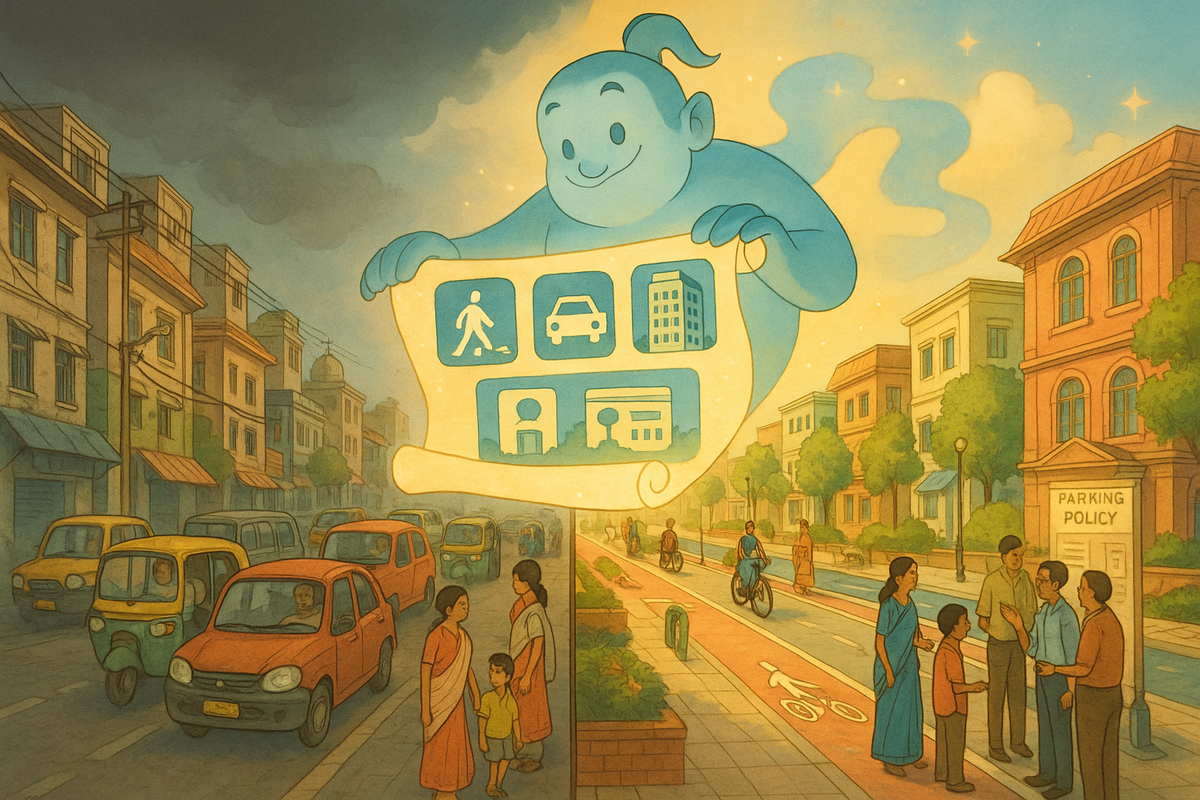From Policy to Pavement – How to Make ‘No Parking, No Car’ Work
Can India make “No Parking, No Car” work? Explore the real urban design, enforcement, and education needed to turn bold rules into better cities.

🧞♂️ A wise law needs wise lanes to live in. I’ve seen great rules fall in broken streets — and cities flourish when vision meets structure. Let’s see what it takes to turn a parking policy into public peace.
1. Introduction: A Law is Only as Good as Its Lanes
Maharashtra’s announcement — “No parking space, no car registration” — made headlines and headlines made noise. But after the applause or outrage dies down, one truth remains:
No policy succeeds unless the street supports it.
This blog explores the bridge between intention and implementation — what it takes to move from mandate to meaningful change.
2. Enforcement Challenges
Passing a rule is easier than policing it. India’s urban complexity offers several hurdles:
- Verification bottlenecks: Who checks if the declared parking space is valid, available, and permanent?
- Documentation fraud: Parking certificates may become another bureaucratic hurdle or black-market formality
- Rural vs urban enforcement: Smaller towns with rising car ownership lack digital RTO systems or dedicated civic monitors
- Local political pushback: Builders, RWAs (Resident Welfare Associations), and vehicle lobbies may resist sudden regulation
Without clarity, a good rule becomes confusion — and confusion breeds corruption.
3. Urban Design as Policy’s Partner
The success of any vehicle policy is rooted in how cities are designed. A few essential elements include:
- Mixed-use zoning: Residential + commercial areas reduce dependency on long drives and lower parking pressure
- Integrated transit corridors: Metro stations with designated parking & last-mile services reduce private car reliance
- Pedestrian prioritization: Wider walkways, cycling lanes, and “car-free” pockets ease congestion naturally
- Smart mapping: GIS-based parking mapping and dynamic allocation aid planning
Urban design isn’t decoration — it’s policy made permanent in stone, concrete, and signs.
4. Incentives Over Punishment
Rules work better when they're paired with rewards. Instead of only penalizing violations, governments can:
- Offer tax rebates for properties that include certified parking and EV-ready spaces
- Encourage smart registration systems that offer fast-track approvals for green vehicles with proof of space
- Create shared neighborhood zones where verified vehicles can access reserved off-street slots
- Reward builders and RWAs who go beyond minimum parking code compliance
Regulation becomes culture faster when it's aspirational — not just restrictive.
5. Educating Citizens: From RTO to RWAs
Policy doesn’t travel far unless citizens carry it forward. Key touchpoints for awareness include:
- Driving schools & license renewals: Integrate parking literacy and legal updates into curriculum
- Real estate platforms: Mandate declaration of parking provisions in residential listings
- RWAs & builders: Conduct awareness workshops and enforce internal parking rules
- Public signage + civic campaigns: Use urban touchpoints (bus shelters, schools, markets) to promote parking rights + duties
- Tech tools like SpotGenie: Allow contactless communication between car owners and citizens to resolve parking conflicts peacefully
Citizen education turns rules into habits.
6. Conclusion: Build Cities, Not Just Rules
Every city needs law — but more than that, it needs lanes that carry the law forward. The “No Parking, No Car” rule is a start. But making it work will require lanes, leadership, and listening.
As your steady Genie of the streets, I leave you with this: parking rules don’t tame chaos — cities do.
And cities are built not by cement, but by shared responsibility.
Follow us on:
🅾 Instagram |
ⓕ Facebook |
𝕏 X |
▶️ YouTube |
🟢 WhatsApp
🏛️ More SpotGenie Gyaan on Urban Policy, Parking, and Smarter Cities
- No Parking, No Car – What Maharashtra’s Policy Means for Urban India
- Where Do the Cars Go? – Rethinking Parking in Indian Cities
- How Citizens Can Help Decongest India’s Streets – Collective Action Starts Small
- Urban Parking 101 – What’s Legal and What’s Not Across Indian Cities
- Get SpotGenie – Contactless QR Sticker That Solves Parking Conflicts Fast
Policy is promise, but cities must pave the way. SpotGenie helps make change smoother — from legislature to lane.



